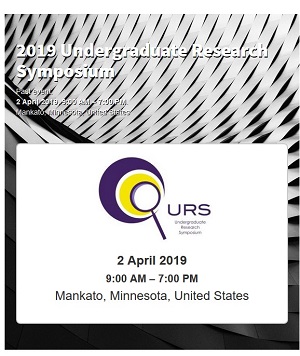Luteinizing and Follicle Stimulating Hormone Receptors in the Seasonally Breeding Green Anole Lizard
Location
CSU Ballroom
Start Date
2-4-2019 10:00 AM
End Date
2-4-2019 11:30 AM
Student's Major
Biological Sciences
Student's College
Science, Engineering and Technology
Mentor's Name
Rachel Cohen
Mentor's Department
Biological Sciences
Mentor's College
Science, Engineering and Technology
Description
Luteinizing and follicle stimulating hormones (LH and FSH) act as signaling molecules in the regulation of reproduction. Within the hypothalamus-pituitary-gonad axis, they control important changes in gonadal tissues. In males, LH signals testicular leydig cells to secrete testosterone which works together with FSH to promote spermatogenesis. In females, LH and FSH signals interact to coordinate follicle growth, ovulation, and estrogen production. Both male and female green anole lizards, Anolis carolinensis, exhibit seasonal changes in gonad size and activation. Facilitated by changing levels of LH and FSH throughout the year, these animals reproduce during the breeding season (BS) and are not receptive during the non-breeding season (NBS). Unpublished work in our lab has shown that injections of gonadotropins during the NBS can cause gonadal growth. LH and FSH receptors in gonadal tissue may be responsible, though seasonal patterns of expression have not been investigated. The purpose of this study is to define the expression levels of LH and FSHR receptors during the BS and NBS. To do this, mRNA was extracted from the gonads of 6 BS males and females, and 6 NBS males and females to be converted into cDNA. Primers for genes encoding for LHR and FSHR were designed and optimized for SYBR green qPCR and used to perform qPCR. Based on preliminary data, we expect there to be receptor expression during the NBS, though there may be less than during the BS. This might suggest that hormonal treatment could induce BS morphology in an NBS gonad.
Luteinizing and Follicle Stimulating Hormone Receptors in the Seasonally Breeding Green Anole Lizard
CSU Ballroom
Luteinizing and follicle stimulating hormones (LH and FSH) act as signaling molecules in the regulation of reproduction. Within the hypothalamus-pituitary-gonad axis, they control important changes in gonadal tissues. In males, LH signals testicular leydig cells to secrete testosterone which works together with FSH to promote spermatogenesis. In females, LH and FSH signals interact to coordinate follicle growth, ovulation, and estrogen production. Both male and female green anole lizards, Anolis carolinensis, exhibit seasonal changes in gonad size and activation. Facilitated by changing levels of LH and FSH throughout the year, these animals reproduce during the breeding season (BS) and are not receptive during the non-breeding season (NBS). Unpublished work in our lab has shown that injections of gonadotropins during the NBS can cause gonadal growth. LH and FSH receptors in gonadal tissue may be responsible, though seasonal patterns of expression have not been investigated. The purpose of this study is to define the expression levels of LH and FSHR receptors during the BS and NBS. To do this, mRNA was extracted from the gonads of 6 BS males and females, and 6 NBS males and females to be converted into cDNA. Primers for genes encoding for LHR and FSHR were designed and optimized for SYBR green qPCR and used to perform qPCR. Based on preliminary data, we expect there to be receptor expression during the NBS, though there may be less than during the BS. This might suggest that hormonal treatment could induce BS morphology in an NBS gonad.
Recommended Citation
Mercer, Kyle. "Luteinizing and Follicle Stimulating Hormone Receptors in the Seasonally Breeding Green Anole Lizard." Undergraduate Research Symposium, Mankato, MN, April 2, 2019.
https://cornerstone.lib.mnsu.edu/urs/2019/poster-session-A/16



